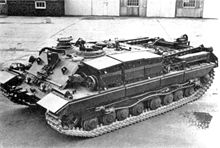Conqueror (tank)
| FV214 Conqueror | |
|---|---|
 Conqueror Mk I at the Bovington Tank Museum | |
| Type | Heavy tank |
| Place of origin | |
| Production history | |
| Manufacturer | Royal Ordnance Factory, Dalmuir |
| No. built | 185 |
| Specifications | |
| Mass | 65 long tons (66 tonnes) |
| Length | 38 ft (11.58 m) gun forward, 25 ft 4 in (7.72 m) hull |
| Width | 13 ft 1 in (4.0 m) |
| Height | 10 ft 5 in (3.2 m) |
| Crew | 4 |
| Armour | 7 inches (178 mm) |
Main armament | L1 120 mm rifled gun |
Secondary armament | 2×7.62 mm machine guns |
| Engine | Rolls-Royce Meteor M120 810 hp (604 kW) |
| Power/weight | 12 hp/tonne |
| Suspension | Horstmann |
Operational range | 65 km |
| Maximum speed | 34 km/h |
The FV214 Conqueror, also known as "Tank, Heavy Gun No 1 120 mm Conqueror"[1] was a British Main Battle Tank of the post-war era, sometimes classified as a heavy tank. It was developed as a response to the Soviet Josef Stalin IS-3 heavy tanks and carried a larger 120 mm gun[2] compared to the contemporaneous Centurion's 20-pounder (83.4 mm). Its role was to provide long range anti-tank support for Centurion tanks. They were issued nine to a regiment in Germany; usually grouped in three tank troops.
Description
The gun design was American, the same as used on the US M103 heavy tank; with separate charge and projectile, as would also be the case in the Chieftain that followed. The charge was not bagged but in a brass cartridge, which offered some safety advantages, but reduced shell capacity to 35.
The armour was very heavy for the time, especially in the front, where it was seven inches (178 mm) in the horizontal plane.[2] Unfortunately, this, along with the weight of the huge turret required to house the large gun and the very large hull volume, made the vehicle very heavy, giving it a relatively low top speed and making it mechanically unreliable. Also, few bridges could support its weight. However, rather like the Second World War Churchill tank, the Conqueror had good terrain handling characteristics and would frequently outrun the lighter (and on paper slightly faster) Centurion on the tank ranges.
One feature of particular note was the rotating commander's cupola, which was at the heart of the Conqueror's fire control system, advanced for its time. The commander could align the cupola on a target independently of the turret, measure the range with a coincidence range finder, and then direct the gunner on to the new lay mechanically indicated to him by the cupola. In theory, when the gunner traversed to the new lay he would find the target already under his sights, ready to be engaged. Meanwhile, the commander was free to search for the next target.
The system may have been inspired by a similar device, without range finder, installed in WWII German Panzers which was apparently highly successful, but was not repeated in subsequent tanks until an updated electronic version of the same idea appeared in the M1 Abrams and Challenger 2 tanks.
Development history
The chassis was from the A45 Infantry Support Tank, started in 1944 shortly after that of the A41 Centurion. After the war the project was relocated to that of the "Universal Tank" design of the FV200 series. The 200 series was to have used a common hull for all uses (self-propelled artillery, armoured personnel carrier, three varieties of tank, etc.). One tank type was to be the heavy FV 201 of 55 tonnes, armed with an 83.4 mm gun.
In 1949 it was decided to bring the armament up to 120 mm. As this delayed the project, in 1952 the FV201 hull was combined with a 17 pounder-armed Centurion Mk 2 turret to give the FV 221 Caernarvon Mark I. Twenty-one wre built with the Mk III 20 pounder turret as the Caernavon Mk II. The FV 221 may originally have been intended to be the "Main Battle Tank" member of the FV201 series, but with the success of the A41 Centurion such a vehicle was no longer required. In either event, the Caernarvon was only used for chassis development work serving in troop trials. In 1955 the first Conqueror was produced. Twenty Mark 1 and 165 Mark 2 Conquerors were built including conversions of Caernavon MkIIs. Production continued until 1959.[2] It had lost much enthusiasm once the Centurion was upgraded to an L7 105mm gun.
Variants

- FV214 Conqueror
- Mk 1
- Mk 2
- Mk 2/1/H - rebuilt Caernarvons
- FV222 Conqueror Armoured Recovery Vehicle (ARV) Mk 1
- 8 Produced
- FV222 Conqueror ARV Mk II
- 20 Produced
- Weight: 57 tons
- Winch capacity: 45 tons
Operators
- United Kingdom 1955-1966. Deployed in West Germany only.
Combat history
- None
Surviving Vehicles

This is an incomplete list.
In the United Kingdom, Conqueror tanks are displayed at the Bovington Tank Museum, and the Land Warfare Hall of the Imperial War Museum Duxford. Other tanks are in the collections of the Musée des Blindés in France, the Royal Museum of the Army in Brussels and the Kubinka Tank Museum, Russia. One is privately owned in the United States as part of the Littlefield Collection.
There are also two MkII ARVs at the Military History Museum on the Isle of Wight. One is shown in the photograph on the right. The second vehicle is off picture to the right. Both are outside and are in a similar condition.

Notes
References
- Ford, Roger. The World's Great Tanks from 1916 to the present day. (1997). Brown Packaging Books Ltd, ISBN 1-897884-29-X.
